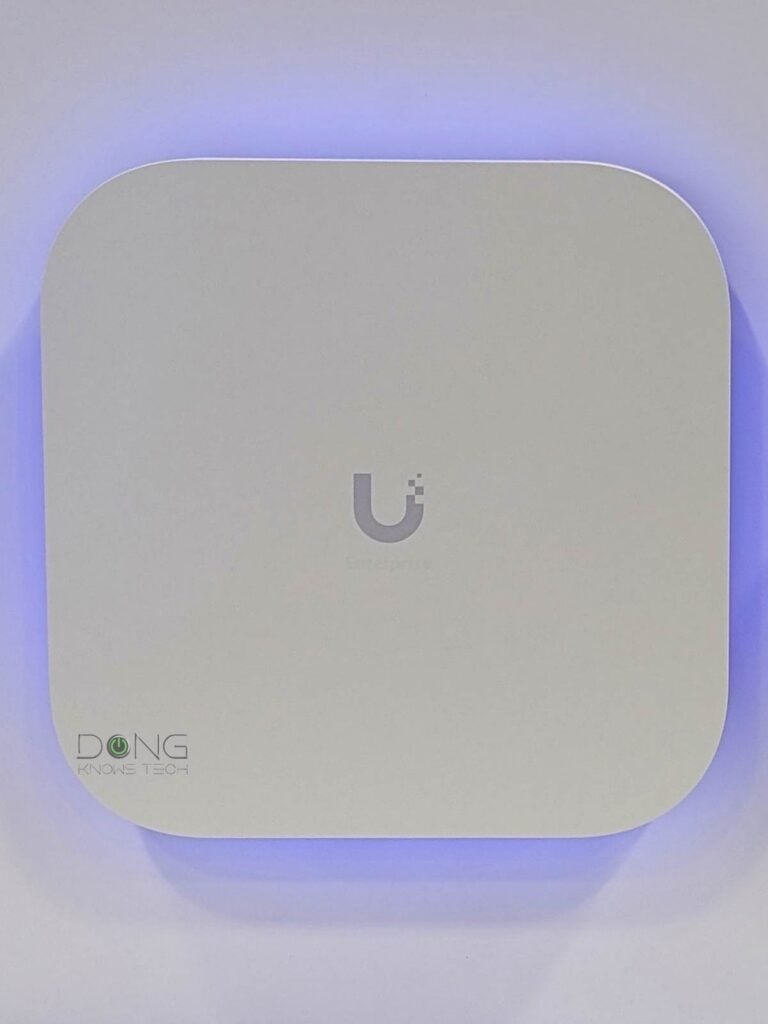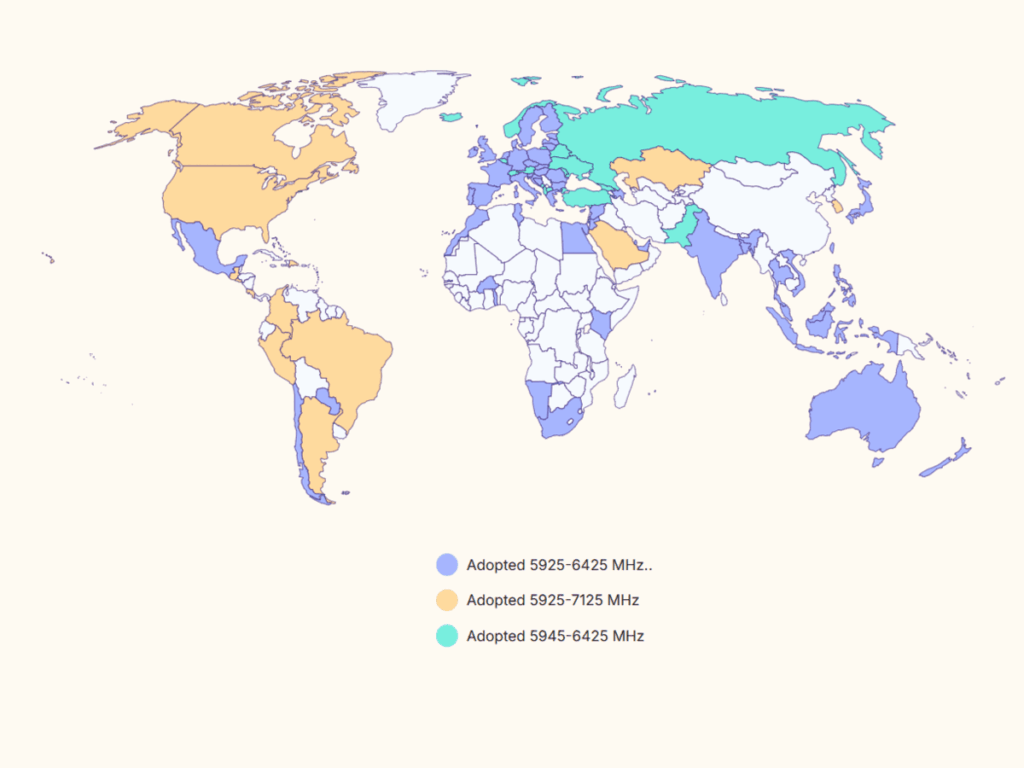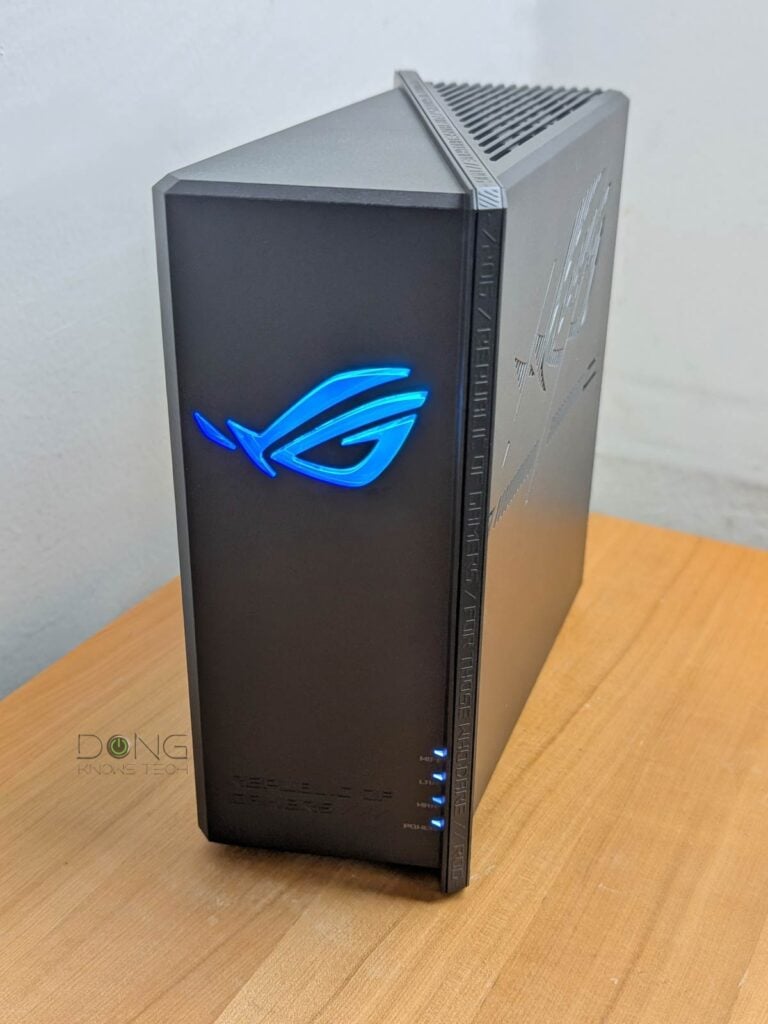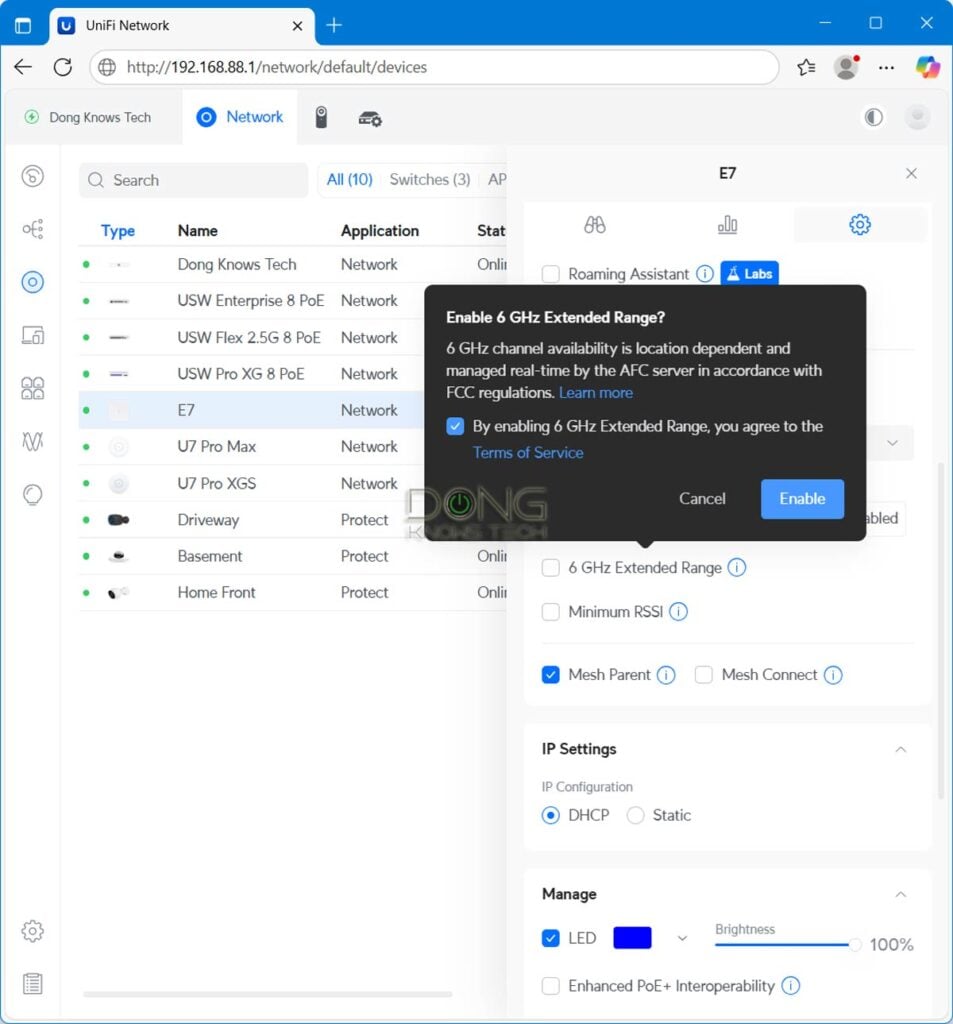Automated Frequency Coordination, or AFC, is a valuable wireless networking feature that has recently become a reality with the release of the Wi-Fi 7 standard. It enables a Wi-Fi 7 broadcaster (router or access point) to significantly increase the range of its super-fast 6GHz frequency band.
However, similar to Wi-Fi 7’s MLO feature, AFC has proven to be a complex concept. This post aims to explain it in detail and set the right expectations based on my real-world testing and serious use of Wi-Fi 7 hardware.

Automated Frequency Coordination: The 6GHz band’s often-elusive extra range
AFC is optional and not required for the general function of a Wi-Fi 7 broadcaster. For that reason, it wasn’t even mentioned in the initial certification of Wi-Fi 7 by the Wi-Fi Alliance. Besides that fact, there are a couple of other things to note about this feature.
AFC’s requirements
The first thing to note is that AFC applies to the 6GHz band and, therefore, is not exclusive to Wi-Fi 7—the band was first used with Wi-Fi 6E. However, this feature was generally not available until Wi-Fi 7.
Due to local regulations, the availability of the 6GHz band—consequently, the implementation of the AFC feature—varies around the world. (Due to this inconsistency, networking vendors have created dual-band Wi-Fi 7 broadcasters that forgo the 6 GHz band entirely.) Still, the point here is that to have AFC, the first requirement is that the broadcaster must have access to the 6GHz band, and that in itself limits the availability of AFC.
How the 6GHz band is regulated around the world
The 6GHz band has a total width of 1200 MHz, ranging from 5.925 MHz to 7.125 MHz, and is divided into 59 channels of 20 MHz each. These channels are grouped to create “sub-bands,” which also vary from one region to another.
In the U.S., the FCC has designated four sub-bands across the entire 6GHz spectrum, including UNII-5, UNII-6, UNII-7, and UNII-8, for Wi-Fi use, though portions of the band may be reserved for other applications.
The E.U. Commission allows only the UNII-5 equivalent part of the frequency for Wi-Fi use, which is 480 MHz in width from 5925 MHz to 6425 MHz. Some other parts of the world are somewhere in between, with the UNII-5 portion adopted and the rest being considered. In the rest, this band may not even be available for Wi-Fi at all.
Generally, Wi-Fi 6E needs a 160MHz channel to deliver the best performance, and Wi-Fi 7 requires double that, 320MHz. Due to spectrum availability and other reasons, real-world hardware tends to use narrower channels in most cases.
Overall, the use of the 6GHz frequency is complicated and is the main reason a Wi-Fi broadcaster made for one region might not work in another.

The table below shows its current adoption worldwide. The “Considering” portion is generally slated to be finalized eventually, though that varies from one region to another.
| Country | Adopted Spectrum |
|---|---|
| United States | 5925-7125 MHz (entire band including UNII5, UNII-6, UNII-7, and UNII-8) |
| Albania | 5945-6425 MHz (UNII-5) |
| Andorra | 5945-6425 MHz |
| Argentina | 5925-7125 MHz |
| Australia | 5925-6425 MHz |
| Austria | 5945-6425 MHz |
| Azerbaijan | 5925-6425 MHz |
| Bahrain | 5925-6425 MHz |
| Bangladesh | 5925-6425 MHz |
| Belarus | 5945-6425 MHz |
| 5945-6425 MHz | |
| Belgium | 5945-6425 MHz |
| Bosnia and Herzegovina | 5945-6425 MHz |
| Brazil | 5925-7125 MHz |
| Bulgaria | 5945-6425 MHz |
| Burkina Faso | 5945-6425 MHz |
| Canada | 5925-7125 MHz |
| Chile | 5925-6425 MHz |
| Colombia | 5925-7125 MHz |
| Costa Rica | 5925-7125 MHz |
| Croatia | 5945-6425 MHz |
| Cyprus | 5945-6425 MHz |
| Czech Republic | 5945-6425 MHz |
| Denmark | 5945-6425 MHz |
| Dominican Republic | 5925-7125 MHz |
| Egypt | 5925-6425 MHz |
| El Salvador | 5925-7125 MHz |
| Estonia | 5945-6425 MHz |
| European Union | 5945-6425 MHz |
| Faroe Islands | 5945-6425 MHz |
| Finland | 5945-6425 MHz |
| France | 5945-6425 MHz |
| Georgia | 5945-6425 MHz |
| Germany | 5945-6425 MHz |
| Gibraltar | 5945-6425 MHz |
| Greece | 5945-6425 MHz |
| Guatemala | 5925-7125 MHz |
| Honduras | 5925-7125 MHz |
| Hong Kong | 5925-6425 MHz |
| Hungary | 5925-6425 MHz |
| Iceland | 5945-6425 MHz |
| India | 5945-6425 MHz |
| Ireland | 5945-6425 MHz 6425-7125 MHz |
| Isle of Man | 5945-6425 MHz |
| Italy | 5945-6425 MHz |
| Japan | 5925-6425 MHz 6425-7125 MHz |
| Jordan | 5925-6425 MHz |
| Kazakhstan | 5925-7125 MHz |
| Kenya | 5925-6425 MHz |
| Latvia | 5925-6425 MHz |
| Liechtenstein | 5945-6425 MHz |
| Lithuania | 5945-6425 MHz |
| Luxembourg | 5945-6425 MHz |
| Macao | 5945-6425 MHz |
| Macedonia | 5945-6425 MHz |
| Malaysia | 5925-6425 MHz |
| Malta | 5925-6425 MHz |
| Mauritius | 5925-6425 MHz |
| Mexico | 5925-6425 MHz |
| Moldova | 5925-6425 MHz |
| Monaco | 5945-6425 MHz |
| Montenegro | 5945-6425 MHz |
| Morocco | 5925-6425 MHz |
| Namibia | 5925-6425 MHz |
| Netherlands | 5945-6425 MHz 6425-7125 MHz |
| New Zealand | 5925-6425 MHz |
| Norway | 5945-6425 MHz |
| Pakistan | 5945-6425 MHz |
| Paraguay | 5925-6425 MHz |
| Peru | 5925-7125 MHz |
| Philippines | 5925-7125 MHz |
| Poland | 5925-7125 MHz |
| Portugal | 5945-6425 MHz 6425-7125 MHz |
| Qatar | 5925-6425 MHz |
| Romania | 5925-6425 MHz |
| Russian Federation | 5925-6425 MHz |
| San Marino | 5925-6425 MHz |
| Saudi Arabia | 5925-7125 MHz |
| Singapore | 5925-6425 MHz |
| Slovakia | 5925-6425 MHz |
| Slovenia | 5925-6425 MHz |
| South Africa | 5925-6425 MHz |
| South Korea | 5925-7125 MHz |
| Spain | 5945-6425 MHz |
| Sweden | 5945-6425 MHz |
| Switzerland | 5945-6425 MHz |
| Thailand | 5925-6425 MHz |
| Togo | 5925-6425 MHz |
| Tunisia | 5925-6425 MHz |
| Turkey | 5925-6425 MHz |
| Ukraine | 5925-6425 MHz |
| United Arab Emirates | 5925-6425 MHz |
| United Kingdom | 5945-6425 MHz |
| Holy See (Vatican City State) | 5945-6425 MHz |
| Vietnam | 5945-6425 MHz |
The second thing to note about the AFC is that, if available, this feature is highly valuable. After all, the 6GHz is among the most significant advantages of Wi-Fi 7, especially when considering its MLO feature, which combines multiple bands into a single link.
In case you’re new: while the 6GHz band has the highest bandwidth (it’s the fastest), it has the shortest range compared to the 5GHz and 2.4GHz bands within the existing maximum allowed broadcasting power. As a result, users can only enjoy this band, either as a separate SSID or as part of a bonded MLO link, at a short distance from the broadcaster, often within line of sight. Further out, or behind a thick wall, the effect of the 6GHz band is reduced or completely non-existent.
The AFC feature fixes the short-range issue. It enables broadcasters to utilize more broadcasting power in the 6GHz band, allowing them to extend their range to be comparable to, or even exceed, that of the 5GHz band.
That’s the idea anyway. Let’s see how the AFC works and, most importantly, when it can be available.

How AFC works and its availability
AFC is implemented at the Wi-Fi broadcasters and enables the hardware to check with a registered local database in real-time to determine a way for its 6GHz band to operate without negatively impacting other existing registered members on the same band.
Once that’s established, the broadcaster uses an exclusive channel in which its 6GHz band (the SSID) can operate outside the constraints of broadcasting regulations. Specifically, it can utilize higher broadcasting power and, via more flexible antennas and FEM designs, achieve a higher signal output.
How much higher, you might ask?
Details vary based on hardware model and locale, but the gist is that with AFC, a Wi-Fi broadcaster may increase the broadcasting power up to 36 dBm (from the current 30 dBm limit) or 4 watts (from 1 watt). In practice, the 6GHz band may exceed the original (non-AFC) maximum allowed power by up to 6dBm, as hardware is often certified for lower than the 30dBm threshold. The goal is to increase the range of the 6GHz band by about 25%, making it comparable to the 5GHz band.
As you can imagine, when this happens, the MLO feature of Wi-Fi 7 becomes significantly more compelling, as the bonded link will offer both improved performance and extended range.
Tip
Automated Frequency Coordination (AFC) extends the Wi-Fi range of the 6GHz band to be comparable to that of the 5GHz band via special rules.
The feature is similar to checking with the local authorities for permission to close off sections of city streets for a drag race block party.
When approved, the usual traffic and parking laws no longer apply to the area, and the organizers can determine how the traffic can flow, among other things.
In any case, the AFC feature requires certification, and its availability is expected to vary from one region to another. Many Wi-Fi 7 broadcasters come with AFC-ready hardware, but this feature must be enabled via firmware updates and is only available where and when its operation meets local requirements during the specified time.

It’s worth noting that hardware vendors generally prioritize compliance and compatibility over performance, so AFC is not the priority. As a result, this feature will be available only in select Wi-Fi 7 broadcasters.
What to expect from AFC in real-world usage
The devil is in the details, and considering there are numerous details in the requirements, the real-world availability and usage of AFC have been complicated.
The “local authorization” notion, for example, entails a lot of uncertainty just by itself. For once, the AFC-enabled Wi-Fi router or access point needs to report its precise GPS coordinates at least once every 24 hours to remain compliant. And getting the coordinates can be a tall order. While most Wi-Fi host devices can determine their rough location via the WAN IP address, that is not precise enough for AFC’s requirements.
For this reason, AFC is more suitable for outdoor Wi-Fi access points, since the hardware itself can easily obtain precise GPS coordinates when placed under an open sky. Additionally, enterprise-class hardware is often more equipped to handle AFC than its consumer-grade counterpart.
After that, there’s a privacy risk when you turn on AFC—you must share your precise location with the hardware vendor and other parties. That’s the reason why, before enabling AFC on a broadcaster, you must accept the additional terms of use or privacy notice.
In my experience, using a supported business-class broadcaster, such as the UniFi E7 AP, is straightforward with AFC. All you have to do is turn it on, and the system will take care of the rest.
On the other hand, using a home router can be complicated. For example, the ASUS GS-BE18000, the first home-grade router with this feature, has no robust way of its own to determine its precise GPS coordinates, and instead puts that burden on a connected client, such as a Wi-Fi 7-enabled smartphone running the ASUS Router mobile app.


In any case, the use of AFC always involves luck and variation in a changing environment. A host device might have AFC at one moment and not at another when it detects that the higher broadcasting power is no longer allowed.
Hopefully, over time, when Wi-Fi 7 is more widely adopted, this feature will have its kinks ironed out both in terms of implementation and local regulations. Until then, it’s a luxury.
The takeaway
Like MLO, the idea behind Automated Frequency Coordination is great. However, its real-world usage requires a lot and, therefore, its effect is often unavailable for the time being, even when supported by the hardware.
The gist is that, for AFC to work, the following have to be met:
- The feature is supported by the Wi-Fi access point (or router) and turned on.
- The access point must report its precise GPS coordinates to the AFC system.
- AFC is only in effect when its function doesn’t affect other devices on the same frequency bands.
That said, the AFC feature is like a jigsaw puzzle with many pieces. It’s challenging to put it together, but when you can do that successfully, the result can be a beautiful thing.



Comments are subject to approval, redaction, or removal. You're in the no-nonsense zone and that applies BOTH ways.
It's generally faster to get answers via site/page search. Your question/comment is one of many Dong Knows Tech receives daily.
Thank you!
(•) If you have subscription-related issues or represent a company/product mentioned here, please use the contact page or a PR channel.